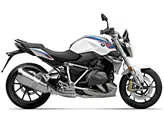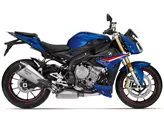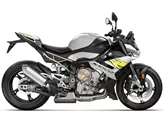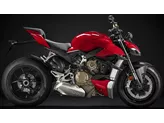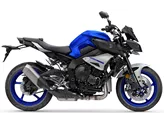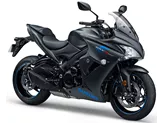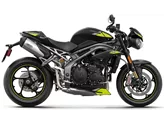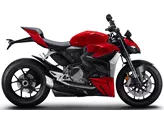BMW S 1000 R 2016 vs. Suzuki GSR 750 2013

BMW S 1000 R 2016

Suzuki GSR 750 2013
Přehled - BMW S 1000 R 2016 vs Suzuki GSR 750 2013
The BMW S 1000 R 2016 and the Suzuki GSR 750 2013 are both naked bikes with similar engine types, inline four-cylinder engines. However, there are significant differences in their technical specifications and overall performance.
In terms of engine power, the BMW S 1000 R 2016 has a clear advantage with 160 HP compared to the Suzuki GSR 750 2013's 106 HP. This means that the BMW offers more power and acceleration, making it a more thrilling and exciting ride. Additionally, the BMW has a higher torque of 112 Nm compared to the Suzuki's 80 Nm, providing better low-end and mid-range power.
Both bikes have a similar frame type, with the BMW featuring an aluminum frame and the Suzuki having a steel frame. The aluminum frame of the BMW is lighter and offers better handling and maneuverability. The steel frame of the Suzuki, on the other hand, may provide more stability and durability.
When it comes to braking, the BMW S 1000 R 2016 has a more powerful braking system with double disc brakes and four pistons at the front. The Suzuki GSR 750 2013, on the other hand, has double disc brakes but with only two pistons. This means that the BMW offers better stopping power and control, enhancing safety and overall performance.

BMW S 1000 R 2016
In terms of dimensions and weights, both bikes have similar front tire widths and diameters. However, the BMW has a wider rear tire width of 190 mm compared to the Suzuki's 180 mm. This wider rear tire provides better traction and stability, especially during aggressive cornering.
The wheelbase of the BMW S 1000 R 2016 is slightly shorter at 1439 mm compared to the Suzuki GSR 750 2013's 1450 mm. This shorter wheelbase contributes to the BMW's nimble and agile handling, making it more suitable for twisty roads and tight corners.
In terms of seat height, both bikes have similar measurements, with the Suzuki having a slightly higher seat height of 815 mm compared to the BMW's 814 mm. This minor difference may not be noticeable for most riders.
Both bikes have a fuel tank capacity of 17.5 liters, providing a decent range for long rides without frequent refueling.
In terms of strengths, the BMW S 1000 R 2016 has a powerful and well-controllable engine, providing exhilarating performance. It also has a powerful braking system, ensuring optimal stopping power. Additionally, it offers a comfortable seating position, allowing for long rides without discomfort.

Suzuki GSR 750 2013
The Suzuki GSR 750 2013, on the other hand, has good ergonomics, providing a comfortable riding position for different body types. Its engine performance is also commendable, although not as powerful as the BMW. The Suzuki also features ABS and instruments that are easy to read, enhancing safety and convenience.
However, both bikes have their weaknesses. The BMW S 1000 R 2016 offers optional extras that are irresistible but expensive, making it a costly choice for some riders. Additionally, its chassis is reported to be hard, which may result in a less comfortable ride on rough roads.
The Suzuki GSR 750 2013, on the other hand, has weak brakes compared to the BMW. Its square swingarm also gives it a cheap-looking appearance. Furthermore, the suspension elements of the Suzuki lack adjustability, limiting the rider's ability to fine-tune the bike's performance to their preferences.
In conclusion, the BMW S 1000 R 2016 and the Suzuki GSR 750 2013 are both capable naked bikes with their own strengths and weaknesses. The BMW offers more power, better braking, and a comfortable seating position, making it a more thrilling and enjoyable ride. The Suzuki, on the other hand, provides good ergonomics, ABS, and easy-to-read instruments. Ultimately, the choice between the two will depend on the rider's preferences and priorities.
Technické údaje BMW S 1000 R 2016 ve srovnání s Suzuki GSR 750 2013
Výhody a nevýhody ve srovnání
Výhody a nevýhody ve srovnání
BMW S 1000 R 2016

U BMW S 1000 R je patrná jak blízká příbuznost se superbikem S 1000 RR, tak snaha vybavit stroj vysokou mírou komfortu pro venkovské cesty a každodenní používání. V souladu s tím je čtyřválcová pohonná jednotka o objemu 1000 cm3 brutální, a přesto snadno ovladatelná, a pozice sedadla je odpovídajícím způsobem sportovní a pohodlná. Skutečnost, že S 1000 R patří mezi cenově nejdostupnější výkonné naháče, je překvapivá a velmi potěšující, i když se člověk nesmí chytit seznamu příplatkové výbavy - protože díky mnoha neodolatelným prvkům bude jistě dražší.
Suzuki GSR 750 2013

Vzhledem k nedostatečným možnostem nastavení je podvozek dobrým kompromisem.
Srovnání cen průměrná tržní cena BMW S 1000 R vs Suzuki GSR 750
There are a few key differences between a BMW S 1000 R 2016 and a Suzuki GSR 750 2013. In terms of price, the actual average price of a BMW S 1000 R 2016 is about 85% higher. A BMW S 1000 R 2016 experiences a loss of 380 USD in one year and 1,940 USD in two years of ownership. This is offset by a loss of 800 USD and 920 USD for a Suzuki GSR 750 2013. There are the same number of bikes of both models available on the 1000PS.de marketplace, specifically 10. It takes less time to sell a Suzuki GSR 750 with 58 days compared to 69 days for the BMW S 1000 R. Since model year 2014 1000PS.de editors have written 62 reviews for the BMW S 1000 R and 12 reviews for the Suzuki GSR 750 since model year 2011. The first review for the BMW S 1000 R was published on 11/3/2013 and now has more than 17,300 views. This compares to more than 5,400 views for the first review on Suzuki GSR 750 published on 10/5/2010.




